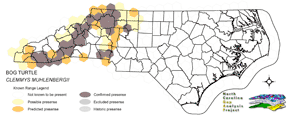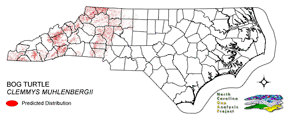
| Taxa: |
| Order: |
| Family: |
| Reptilia |
| Testudines |
| Emydidae |
| NatureServe Global Rank: |
| NatureServe State (NC) Rank: |
| G3 |
| S2 |
| Federal Status: |
| NC State Status: |
| T(S/A) |
| T |


| Land Unit |
| US Fish & Wildlife Service |
| US Forest Service |
| US National Park Service |
| US Department of Defense |
| NC State Parks |
| NC University System |
| NC Wildlife Res. Com. |
| NC Forest Service |
| NC Div. of Coastal Mgmt. |
| Local Governments |
| Non-Governmental Org. |
| Other Public Lands |
| Private Lands |
| GAP Status 1-2 |
| All Protected Lands |
| Statewide |
| Hectares |
| 3.15 |
| 9,086.85 |
| 3.51 |
| 1,669.41 |
| 338.94 |
| 2.07 |
| 213.48 |
| 225.60 |
| 0.00 |
| 65.16 |
| 209.34 |
| 104.31 |
| 385,056.27 |
| 2,713.56 |
| 11,792.31 |
| 396,978.09 |
| Acres |
| 7.78 |
| 22,454.09 |
| 8.67 |
| 4,125.20 |
| 837.54 |
| 5.12 |
| 527.52 |
| 821.53 |
| 0.00 |
| 161.01 |
| 517.29 |
| 257.76 |
| 951,494.58 |
| 6,969.41 |
| 29,403.48 |
| 981,218.09 |
| % of Dist. on |
| Prot. Lands |
| < 0.1 % |
| 77.1 % |
| < 0.1 % |
| 14.2 % |
| 2.9 % |
| < 0.1 % |
| 1.8 % |
| 1.9 % |
| 0.0 % |
| 1.6 % |
| 1.6 % |
| < 0.1 % |
| 0.0 % |
| 23.0 % |
| ----- |
| ----- |
| % of Dist. on |
| All Lands |
| < 0.1 % |
| 2.3 % |
| < 0.1 % |
| 0.4 % |
| < 0.1 % |
| < 0.1 % |
| < 0.1 % |
| < 0.1 % |
| 0.0 % |
| < 0.1 % |
| < 0.1 % |
| < 0.1 % |
| 97.0 % |
| 0.7 % |
| ----- |
| ----- |
|
Rare, with a scattered distribution in the mountains and a small area of the western piedmont (Martof et al. 1980). NATURE SERVE GLOBAL HABITAT COMMENTS: Slow, shallow, muck-bottomed rivulets of sphagnum bogs, calcareous fens, marshy/sedge-tussock meadows, spring seeps, wet cow pastures, and shrub swamps; habitat usually contains an abundance of grassy or mossy cover. Commonly basks on tussocks in the morning in spring and early summer. Burrows into soft substrate of waterways, crawls under sedge tussocks, or enters muskrat burrows during periods of inactivity in summer (see Bury 1979). In Pennsylvania, hibernated mainly in water and mud in muskrat burrows, and in mud bottom of marsh rivulets under 5-15 cm of water. In New Jersey, hibernacula were in subterranean rivulets or seepage areas where water flowed continuously from underground springs; turtles were under 5-55 cm of water and mud (see Ernst et al. [1989] for further details). In Maryland, larger population sizes were associated with sites with the following characteristics: circular basin with spring-fed pockets of shallow water, bottom substrate of soft mud and rock, dominant vegetation of low grasses and sedges, and interspersed wet and dry pockets; winter retreats were shallow, just below upper surface of frozen mud and/or ice (Chase et al. 1989). Studies in Maryland and Pennsylvania noted use of the lower portion of wetlands for overwintering. Nests in open and elevated ground in areas of moss, grassy tussocks, or moist earth (see Bury 1979). Digs shallow nest or lays eggs in the top of a sedge tussock. NATURE SERVE STATE HABITAT COMMENTS: Sphagnum bogs, slowly drained swamps, mucky, slow moving spring-fed streams in meadows and pastures. Associated plants include: tag alder, red maple, silky willow, swamp rose, spotted jewelweed, tearthumb, sedges, bog rushes, cinnamon fern, marsh fern, sensitive fern, sphagnum moss. Habitats of this type are usually less than 4 acres in size. |
| Code | Name | Description | NC Natural Heritage Program Equivalent |
| 239 | Piedmont/Mountain Emergent Vegetation | Emergent vegetation of all wetland hydrologies. Sites would commonly support species such as tussock sedge, rushs, and cattail alliances. | Rocky Bar and Shore (in part) |
| 205 | Agricultural Pasture/Hay and Natural Herbaceous | Farm fields used for pasture grass or hay production, as well as old fields dominated by native and exotic grasses. | No equivalent |
| 534 | Appalachian Wet Shrubland/ Herbaceous | Saturated shrubs and herbaceous vegetation. Often mapped as an inclusion in Appalachian Swamp Forest. | Southern Appalachian Bog, Southern Appalachian Fen |
|
Merkle, D. A. 1975. A taxonomic analysis of the CLEMMYS complex (Reptilia:Testudines) utilizing starch gel electrophoresis. Herpetologica 31:162-166.
Kiviat, E. 1978. BOG TURTLE HABITAT ECOLOGY. BULL. CHI. HERP. SOC., 13(2):29-42. Arndt, R.G. 1980. THE BOG TURTLE- AN ENDANGERED SPECIES? P. 99-107. IN:P. WRAY (ED). PROCEEDINGS OF THE NORTHEAST ENDANGERED SPECIES CONFERENCE, PROVINCETOWN. 170 PP. Bickham, J. W., T. Lamb, P. Minx, and J. C. Patton. 1996. Molecular systematics of the genus CLEMMYS and the intergeneric relationships of emydid turtles. Herpetologica 52:89-97. U. S. Fish and Wildlife Service (USFWS). 29 January 1997. Proposed rule to list the northern population of the bog turtle as threatened and the southern population as threatened due to similarity of appearance. Federal Register 62(19):4229-4239. Conant, R. and J. T. Collins. 1991. A field guide to reptiles and amphibians:eastern and central North America. Third edition. Houghton Mifflin Co., Boston, Massachusetts. 450 pp. Tryon, B. W. 1989. The bog turtle, CLEMMYS MUHLENBERGII, in Tennessee, 1989. Progress report submitted to Tennessee Wildlife Resources Agency. Herman, D. W., and K. M. Fahey. 1992. Seasonal activity and movements of bog turtles (CLEMMYS MUHLENBERGII) in North Carolina. Copeia 1992:1107-1111. Ernst, C. H., and R. B. Bury. 1977. Clemmys muhlenbergii. Cat. Am. Amph. Rep. 204.1-204.2. Chase, J. D., et al. 1989. Habitat characteristics, population size, and home range of the bog turtle, CLEMMYS MUHLENBERGII, in Maryland. J. Herpetol. 23:356-362. Ernst, C. H., R. T. Zappalorti, and J. E. Lovich. 1989. Overwintering sites and thermal relations of hibernating bog turtles, CLEMMYS MUHLENBERGII. Copeia 1989:761-764. Zappalorti, R. T., and G. Rocco. 1993. Surveys, habitat evaluations and ecological studies of the bog turtle (CLEMMYS MUHLENBERGII) in Chester and Lancaster counties, Pennsylvania, with recommendations on its conservation and management. 76 pp. Report sub Collins, D. E. 1990. Western New York bog turtles:relicts of ephemeral islands or simply elusive? Pages 151-153 in Mitchell et al., eds. Ecosystem management:rare species and significant habitats. New York State Mus. Bull. 471. Eckler, J. T., A. R. Breisch, and J. L. Behler. 1990. Radio telemetry techniques applied to the bog turtle (CLEMMYS MUHLENBERGII Schoepff 1801). Pages 69-71 in Mitchell et al., eds. Ecosystem management:rare species and significant habitats. New York Stat McDowell, S. B. 1964. Partition of the genus CLEMMYS and related problems in the taxonomy of the aquatic testudinidae. Proc. Zool. Soc. London 143:239-279. Ernst, C. H., and R. W. Barbour. 1972. Turtles of the United States. Univ. Press of Kentucky, Lexington. x + 347 pp. Behler, J. L., and F. W. King. 1979. The Audubon Society field guide to North American reptiles and amphibians. Alfred A. Knopf, New York. 719 pp. Bury, R. B. 1979. Review of the ecology and conservation of the bog turtle, CLEMMYS MUHLENBERGII. USFWS Spec. Sci. Rep.--Wildl. 219:1-9. Landry, J.L. 1979. A BIBLIOGRAPHY OF THE BOG TURTLE, CLEMMYS MUHLENBERGII (BIOLOGY, ECOLOGY AND DISTRIBUTION). SMITHSONIAN HERPETOLOGICAL INFORMATION SERVICE, NO. 44:1-21. Martof, B. S., W. M. Palmer, J. R. Bailey, and J. R. Harrison, III. 1980. Amphibians and reptiles of the Carolinas and Virginia. University of North Carolina Press, Chapel Hill, North Carolina. 264 pp. Herman, D.W. 1981. Status of the bog turtle in the southern Appalachians. pp. 77-80. In R.R. Odom and J.W. Guthrie (eds.). Proceedings of the nongame and endangered wildlife symposium. GA Dept. of Nat. Res., Tech. Bull. WL5, 179 pp. DeGraaf, R. M., and D. D. Rudis. 1983. Amphibians and reptiles of New England. Habitats and natural history. Univ. Massachusetts Press. vii + 83 pp. Ernst, C. H., and R. W. Barbour. 1989. Turtles of the world. Smithsonian Institution Press, Washington, D.C. xii + 313 pp. Lovich, J. E., et al. 1991. Relationships among turtles of the genus CLEMMYS (Reptilia, Testudines, Emydidae) as suggested by plastron scute morphology. Zoologica SCripta 20:425-429. Mitchell, J. C. 1991. Amphibians and reptiles. Pages 411-76 in K. Terwilliger (coordinator). Virginia's Endangered Species:Proceedings of a Symposium. McDonald and Woodward Publishing Company, Blacksburg, Virginia. |
For more information please contact them at:
NC-GAP Analysis Project
Dept. of Zoology, NCSU
Campus Box 7617
Raleigh, NC 27695-7617
(919) 513-2853
www.basic.ncsu.edu/ncgap